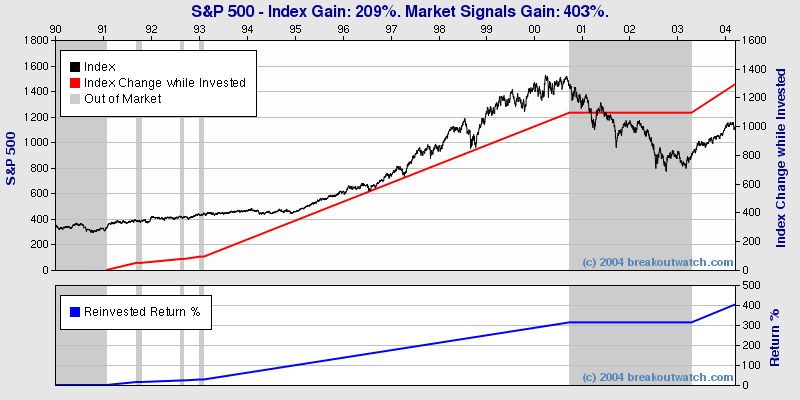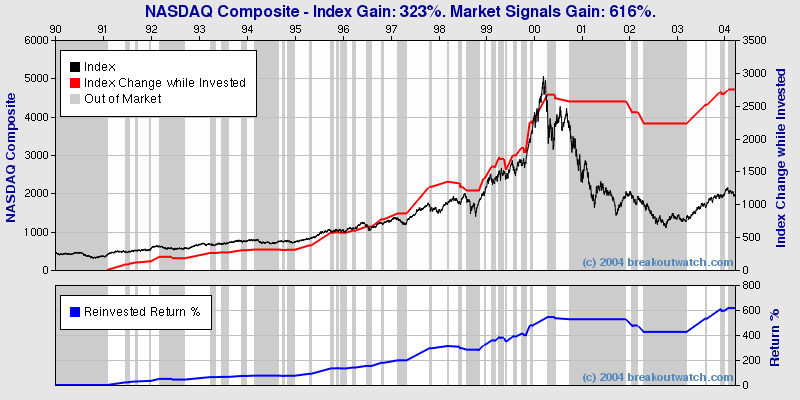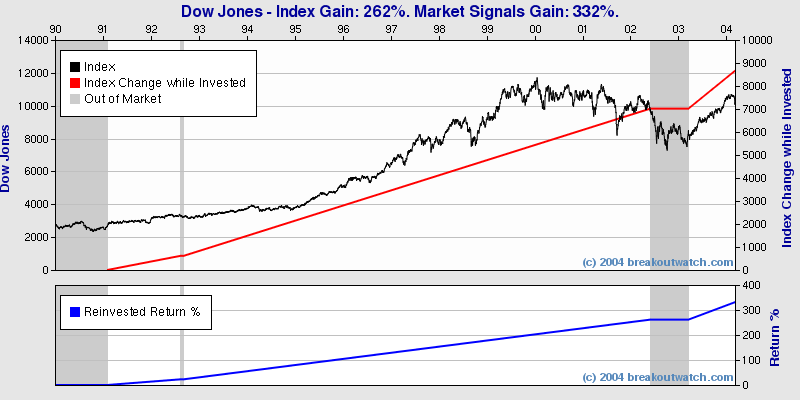Using William O'Neil's comments on market timing in 'How to Make Money in Stocks' and additional information provided in 'The Successful Investor', together with the results of our own research, we have developed a model for each of the major markets that identifies market tops and bottoms. These models were built using DJI and S&P 500 data back to 1950 and NASDAQ composite data since its inception in 1984.
Using these models we are now able to indicate the points at which one can enter or leave each of the three major markets. These will be shown each day based on the previous day's trading as either 'enter' or 'exit'. Once an enter or exit signal is given, it stays at the same value until a contrary signal is given.
Back Testing of these models gave the following returns through to 03/16/04 compared to remaining fully invested in any one of the indexes:
| Index | Returns since 1950 (1984 for NASDAQ) |
Returns since 1990 | ||
| Index | Using Signals | Index | Using Signals | |
| DJI | 5021% | 5080% | 262% | 332% |
| S&P 500 | 6567% | 9853% | 209% | 403% |
| NASDAQ | 694% | 866% | 323% | 616% |
These market entry or exit signals are, of course, based on past performance which is no guarantee of future success.
O'Neil says 'three to five days (in recent years it's been five days) of volume distribution over a span of two to four weeks is sufficient to turn the market's uptrend into a downtrend.' (The Successful Investor. p3). While this seems reasonably precise, we applied these rules to the three major market indexes back to 1950 for the Dow and S&P, and back to 1984, for the NASDAQ, and found they are broadly correct but a literal interpretation generated several false downturns and also missed some important ones. We also found there were important differences between the three market indexes as to how many distribution days over what period reliably signaled a downturn.
We were able to identify specific values of the number of distribution days and the period over which they must occur for each of the three major indices. We were surprised that there were marked differences between the number of distribution days and the period over which they must occur that signaled a downturn in the Dow Jones Index compared to those needed to signal a downturn in the S&P and NASDAQ.
These differences are important, since false downturn signals can be costly because by the time you realize the signal was false, the market can already have moved higher, and the cost of buying back in can be higher than the price obtained when getting out.
We also found that this method of determining market tops worked better for the NASDAQ and S&P 500 than for the Dow. Since the CANTATA methodology is not designed for established 'blue chips' such as as are found in the Dow, then perhaps this is not surprising.
O'Neil advises that market bottoms can be recognized when the downtrend stops and one of the market indexes is up about 1.7% or more on the fourth through eleventh day of the rally. (The Successful Investor, p.9). Over the years O'Neil has modified his percentage gain requirement from 1% to 2% (HTMIS, v3, p.65).
Once again, we applied these guidelines to the three major market indexes and found them to be generally true but that again there were several false signals generated. We were able to make adjustments to the guidelines for each of the three markets to the point where during the recent bear market no false signals were generated in the S&P or Dow, and only three in the NASDAQ.
The following charts show the Enter and Exit signals for the three major indexes since 1990 through to 03/16/04. The vertical gray areas are times when the 'Exit' signal had been triggered, reverting to white when the 'Enter' signal is triggered.. The top chart of each pair shows the closing values of the index and the aggregate change in the index while the 'Enter' signal was active. The bottom chart of each pair shows the total return if the amount taken out of the market at each exit point is fully reinvested at the next entry point.
Note that the DJI did not give an exit signal on or after 9/11/2001. Sudden exogenous shocks like this cannot be anticipated by any market timing system. The other indexes had already signaled an exit prior to 9/11/2001.


